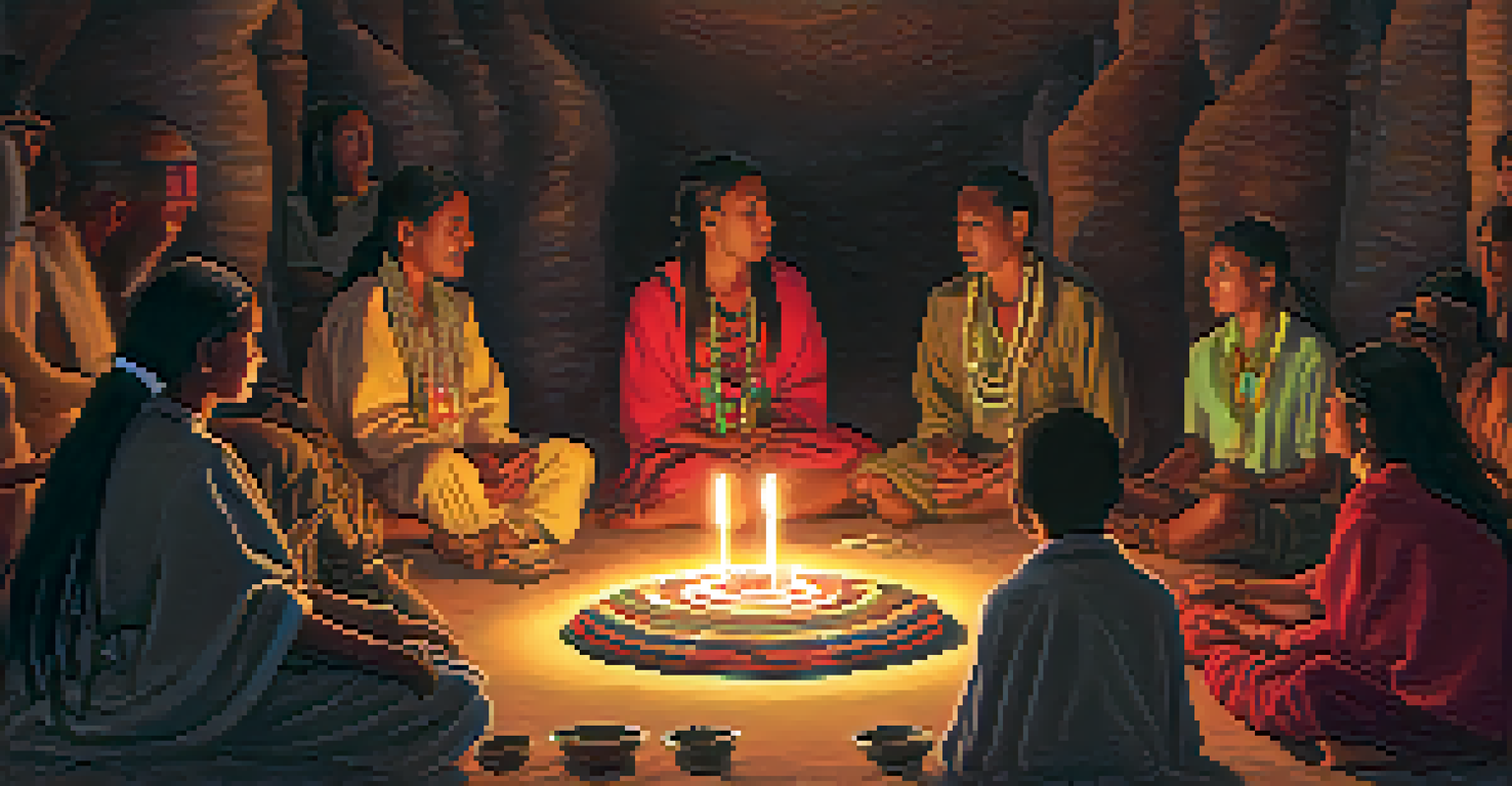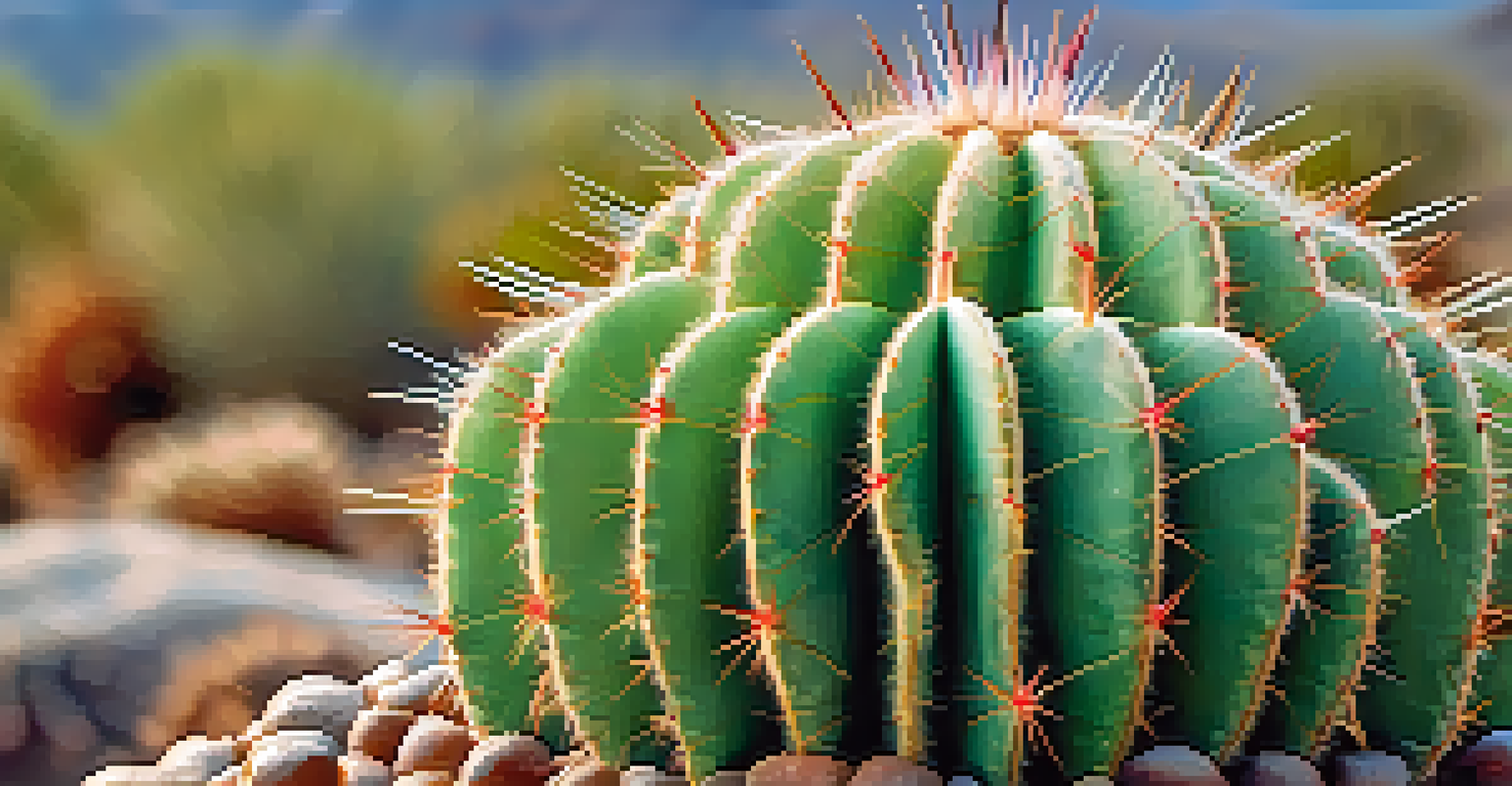Peyote and Its Influence on Cultural Identity and Heritage

Understanding Peyote: A Brief Overview
Peyote is a small, spineless cactus native to Mexico and the southwestern United States, famous for its psychoactive properties. It contains mescaline, a natural hallucinogen that has been used for centuries in various Indigenous cultures for spiritual and medicinal purposes. This sacred cactus not only plays a crucial role in religious ceremonies but also serves as a symbol of cultural identity for many Native American tribes.
Peyote is not merely a substance; it is a vital part of the spiritual and cultural identity of Indigenous peoples.
The use of peyote can be traced back to ancient Mesoamerican civilizations, highlighting its deep-rooted significance in cultural practices. For communities like the Huichol, the journey to find and harvest peyote is a rite of passage that embodies their connection to the earth and their ancestors. This relationship with the cactus transcends mere consumption; it represents a spiritual bond that reinforces their cultural heritage.
As we delve into the world of peyote, it becomes clear that its influence extends beyond the individual, shaping collective identity and community values. Understanding this context is essential for appreciating how peyote contributes to the mosaic of cultural heritage among Indigenous peoples.
Peyote in Indigenous Spiritual Practices
For many Indigenous tribes, peyote is central to their spiritual practices, often used in religious ceremonies known as 'peyote meetings.' These gatherings provide a space for community members to connect, share, and heal through the collective experience of consuming peyote. The rituals surrounding these ceremonies emphasize the importance of tradition, storytelling, and the shared responsibility of preserving cultural practices.

During these meetings, participants engage in prayer, singing, and drumming, creating a profound sense of unity and belonging. The transformative experiences induced by peyote often lead to personal revelations and insights, further solidifying the importance of this sacred plant in their spiritual lives. This deep-rooted practice not only serves as a means of spiritual connection but also fortifies social cohesion within the community.
Peyote's Role in Indigenous Culture
Peyote is essential to Indigenous spiritual practices, serving as a medium for connection, healing, and cultural identity.
Moreover, the resurgence of interest in peyote rituals among younger generations highlights the ongoing relevance of these practices. As they seek to reclaim their cultural identity, many are turning to peyote as a symbol of resistance against cultural erasure and colonization.
Cultural Heritage and Identity Formation
Peyote plays a significant role in shaping cultural identity, particularly among Native American communities. It serves as a medium through which individuals connect with their heritage, fostering a sense of pride and belonging. For many, participating in peyote ceremonies is not just about the experience itself but also about honoring the traditions of their ancestors and passing them down to future generations.
The preservation of cultural practices is essential for fostering community resilience and identity.
The act of gathering for peyote rituals reinforces cultural values and teachings, ensuring that knowledge and practices are preserved. In this way, peyote becomes a living embodiment of cultural identity, linking the past with the present. The stories told during these ceremonies often reflect the history, struggles, and triumphs of the community, creating a tapestry of shared experiences.
In a world where many Indigenous cultures face challenges, peyote rituals offer a vital space for cultural revitalization. As individuals embrace their heritage through these practices, they contribute to a broader movement of cultural resilience and pride.
Legal Challenges Surrounding Peyote Use
Despite its significance, the use of peyote faces numerous legal challenges, particularly in the United States. The federal government classifies peyote as a Schedule I controlled substance, which restricts its use outside of specific religious contexts. This legal framework poses obstacles for Indigenous communities seeking to practice their traditions freely and without fear of prosecution.
Many tribes have fought for the right to use peyote in their spiritual practices, often citing the Religious Freedom Restoration Act. Legal battles have highlighted the tension between Indigenous rights and government regulations, raising questions about the protection of cultural heritage. These challenges underscore the broader issues of sovereignty and self-determination faced by Native American communities.
Legal Challenges for Peyote Use
Despite its cultural significance, peyote faces legal obstacles that hinder Indigenous communities from practicing their traditions freely.
Efforts to advocate for the legal protection of peyote use continue, as many see it as essential to preserving their cultural identity. The ongoing dialogue around peyote legality showcases the intersection of tradition, spirituality, and modern legal frameworks.
Peyote and the Modern Cultural Landscape
In recent years, there has been a growing interest in peyote beyond Indigenous communities, particularly within the realms of therapy and wellness. Some individuals are exploring its potential benefits for mental health, sparking discussions about the ethical implications of non-Indigenous use. This growing fascination raises important questions about cultural appropriation and respect for sacred traditions.
While some advocates argue for the therapeutic potential of peyote, others emphasize the need to honor its cultural significance. Navigating this landscape requires sensitivity and awareness of the historical context surrounding peyote use. It's crucial to recognize that for many Indigenous peoples, peyote is not merely a substance but a vital part of their spiritual and cultural identity.
As the conversation around peyote evolves, it serves as a reminder of the importance of respecting cultural heritage. Engaging with these discussions thoughtfully can help bridge the gap between Indigenous and non-Indigenous experiences, fostering mutual understanding and respect.
The Ecological Impact of Peyote Harvesting
The harvesting of peyote is not without its ecological implications, raising concerns about sustainability and conservation. As demand increases, the natural habitats of peyote face potential threats, leading to overharvesting and depletion of this sacred plant. For Indigenous communities, this poses a significant challenge, as the availability of peyote is crucial for maintaining their cultural practices.
Efforts are being made to promote sustainable harvesting practices within Indigenous communities, ensuring that peyote remains available for future generations. These practices often involve traditional ecological knowledge, emphasizing the importance of respecting the land and its resources. By integrating these principles, communities can continue to honor their cultural heritage while safeguarding the environment.
Sustainability in Peyote Harvesting
The increasing demand for peyote raises ecological concerns, prompting efforts within Indigenous communities to promote sustainable harvesting practices.
The conversation around peyote harvesting highlights the interconnectedness of culture and ecology. As communities advocate for responsible practices, they not only protect their heritage but also contribute to broader environmental preservation efforts.
Peyote as a Symbol of Resilience and Identity
Ultimately, peyote stands as a powerful symbol of resilience and cultural identity for many Indigenous peoples. It embodies the struggles and triumphs of communities as they navigate the complexities of modern life while holding onto their traditions. This sacred cactus serves as a reminder of the strength found in cultural heritage and the importance of preserving it for future generations.
By participating in peyote rituals, individuals reaffirm their connection to their ancestors and their cultural roots. This act of remembrance and celebration fosters a sense of belonging and community, reinforcing the idea that identity is a living, evolving concept. As younger generations embrace peyote as part of their cultural identity, they actively participate in the ongoing narrative of their people.

In conclusion, peyote is more than just a plant; it is a vital thread woven into the fabric of cultural identity and heritage. Its influence extends far beyond individual experiences, shaping collective narratives and fostering resilience in the face of adversity.